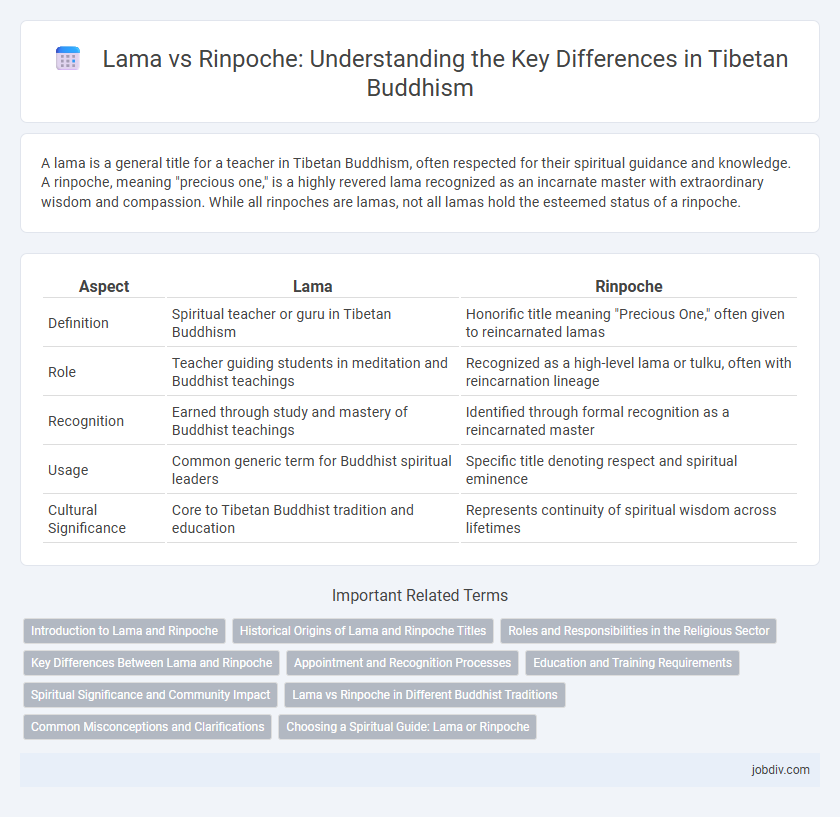A lama is a general title for a teacher in Tibetan Buddhism, often respected for their spiritual guidance and knowledge. A rinpoche, meaning "precious one," is a highly revered lama recognized as an incarnate master with extraordinary wisdom and compassion. While all rinpoches are lamas, not all lamas hold the esteemed status of a rinpoche.
Table of Comparison
| Aspect | Lama | Rinpoche |
|---|---|---|
| Definition | Spiritual teacher or guru in Tibetan Buddhism | Honorific title meaning "Precious One," often given to reincarnated lamas |
| Role | Teacher guiding students in meditation and Buddhist teachings | Recognized as a high-level lama or tulku, often with reincarnation lineage |
| Recognition | Earned through study and mastery of Buddhist teachings | Identified through formal recognition as a reincarnated master |
| Usage | Common generic term for Buddhist spiritual leaders | Specific title denoting respect and spiritual eminence |
| Cultural Significance | Core to Tibetan Buddhist tradition and education | Represents continuity of spiritual wisdom across lifetimes |
Introduction to Lama and Rinpoche
Lama and Rinpoche are significant titles within Tibetan Buddhism, reflecting different roles and levels of spiritual attainment. Lama is a general term for a teacher or guru who guides disciples on the path to enlightenment, often ordained monks or experienced practitioners. Rinpoche, meaning "precious one," is an honorific reserved for highly respected teachers recognized for their profound wisdom, often reincarnated masters or tulkus who hold a special spiritual lineage.
Historical Origins of Lama and Rinpoche Titles
The titles Lama and Rinpoche have distinct historical origins within Tibetan Buddhism, where Lama denotes a spiritual teacher or guru often linked to monastic lineage and scholastic achievements. Rinpoche, meaning "precious one," originated as an honorific title conferred upon highly revered reincarnated masters or tulkus recognized for their spiritual accomplishments and divine insight. The Lama title reflects a broader teaching role rooted in early Vajrayana traditions, while Rinpoche emphasizes the sacred nature and reincarnated status of specific distinguished individuals.
Roles and Responsibilities in the Religious Sector
Lamas serve primarily as spiritual teachers and leaders within Tibetan Buddhism, responsible for guiding meditation practices and conducting religious ceremonies. Rinpoches are recognized as highly esteemed reincarnated masters who hold the authority to interpret sacred texts and bestow advanced teachings. Both hold distinct yet complementary roles in preserving doctrinal wisdom and facilitating spiritual growth among followers.
Key Differences Between Lama and Rinpoche
Lama and Rinpoche are both honorific titles in Tibetan Buddhism but denote different statuses and roles. A Lama is a spiritual teacher or guru with authority to guide disciples, often recognized for their knowledge and practice. Rinpoche, meaning "precious one," is a title given to highly revered teachers, often believed to be reincarnated masters or tulkus, signifying exceptional spiritual accomplishment and respect.
Appointment and Recognition Processes
Lamas are Tibetan Buddhist teachers appointed through formal training and lineage-based authorization, often recognized by senior monastic authorities within specific schools. Rinpoches, meaning "precious ones," are typically identified as reincarnated masters (tulkus) through a rigorous process involving senior lamas, divination, and prophetic signs confirming their rebirth. The recognition of Rinpoches carries spiritual authority and responsibility, legitimized by historical lineage confirmation and community acknowledgment.
Education and Training Requirements
Lamas undergo extensive monastic education, often beginning with foundational studies in Buddhist philosophy, scripture, and meditation practices, followed by advanced training in ritual and teaching responsibilities. Rinpoche, a title meaning "precious one," is typically bestowed upon recognized reincarnate masters who receive specialized mentorship and rigorous training in both esoteric and exoteric Buddhist teachings from an early age. The educational path for Rinpoches involves not only scholarly study but also spiritual guidance under senior teachers to prepare for their roles as spiritual leaders and lineage holders.
Spiritual Significance and Community Impact
Lamas, often recognized as spiritual teachers in Tibetan Buddhism, hold a significant role in guiding practitioners through religious teachings and rituals, fostering deep spiritual growth within the community. Rinpoche, a title meaning "precious one," denotes highly revered teachers believed to be reincarnated masters, whose recognition inspires faith and continuity in the lineage. The spiritual significance of Rinpoches elevates their community impact, as they often serve as central figures in maintaining religious traditions and imparting wisdom across generations.
Lama vs Rinpoche in Different Buddhist Traditions
Lama and Rinpoche titles hold distinct significance across various Buddhist traditions, with "Lama" commonly used in Tibetan Buddhism to denote a spiritual teacher or guru, while "Rinpoche," meaning "precious one," is an honorific reserved for highly respected reincarnated masters or esteemed teachers. In traditions such as the Gelug and Kagyu schools, "Rinpoche" is often linked to recognized tulkus, whereas "Lama" can be applied more broadly to qualified teachers regardless of reincarnation status. Understanding the nuanced use of these titles is essential for appreciating the hierarchical and spiritual roles within different Buddhist lineages.
Common Misconceptions and Clarifications
Lama and Rinpoche are titles used within Tibetan Buddhism that often cause confusion due to their overlapping respect and spiritual significance. A Lama is generally a spiritual teacher or guru, while Rinpoche, meaning "precious one," is a title reserved for highly respected teachers who are often recognized as reincarnated masters or tulkus. Misconceptions arise when Rinpoche is assumed to be a higher rank than Lama, but both titles denote deep reverence and spiritual authority, with their use depending on context, lineage, and specific religious traditions.
Choosing a Spiritual Guide: Lama or Rinpoche
Choosing a spiritual guide involves understanding the roles of both Lama and Rinpoche in Tibetan Buddhism. A Lama is a teacher who imparts Dharma teachings and guides practitioners on their spiritual path, often recognized for their training and wisdom. Rinpoche, meaning "precious one," is an honorific title granted to highly respected tulkus or reincarnated masters who have demonstrated exceptional realization and carry profound spiritual authority.
Lama vs Rinpoche Infographic

 jobdiv.com
jobdiv.com